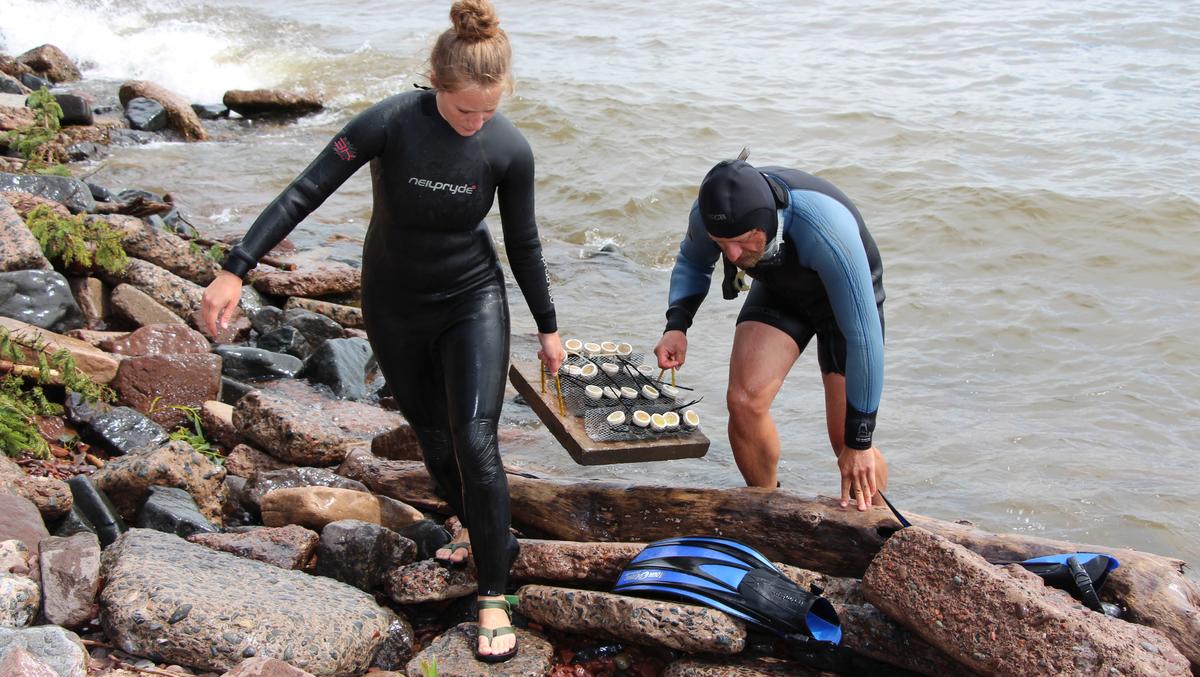The tiles were placed underwater at 10 different locations a month prior. Little plastic cups attached to these tiles will provide the basis of their findings for a summer’s worth of research. Shannon McCallum, a senior biology student, along with her professor Dr. Ted Ozersky, is studying what limits the growth of benthic algae, the algae that live and grow on the bottom of Lake Superior, as part of the Biology Undergraduate Research in Science and Technology (BURST) Program.
Unique Research Opportunity
Dr. Ozersky has been with the university for two years, splitting his time between the Large Lakes Observatory and the Biology Department. This is his first summer with the BURST program, and he and Shannon have chosen a rarely researched subject for their work.
There has been a lot of research on the phytoplankton (algae living in the water column) of Lake Superior, but not on the periphyton in the lake. “I’m kind of a trend setter in the field,” said McCallum, “There’s a lot of stream research on periphyton, but not in this setting.”
The main objective of the study is to pinpoint what makes the algae grow the most, and that’s going to be the most limiting macronutrient. McCallum chose two nutrients to test: phosphorus and nitrogen. This is where the cups attached to the tiles come into play. There are four different types of cups attached to the tiles placed in the lake. One type with no added nutrients, one with phosphorus, one with nitrogen, and one with both nitrogen and phosphorus.
Before and after photos of the cement tiles.
“I chose phosphorus and nitrogen because they’re the most common limiting nutrients in freshwater ecosystems,” said McCallum.
When McCallum and Ozersky pick up the tiles, with the help of fellow BURST student Ben Block, they will be measuring the amount of algae that have grown on them, and this will give a fuller picture of what’s happening in Lake Superior.
Shannon and Ben getting the YSI ready for measurements.
The experimental tiles were placed all the way from Silver Bay in Minnesota to Poplar River in Wisconsin I. Visiting that many sites made for long days when the researchers went out to check on their tiles weekly and gather readings, but this large range was purposeful and the trek was necessary for their research.
“Water clarity changes depending on different land use and weather patterns. There are places with a lot of industry, agriculture, rural areas and urban areas along the coast of the city of Duluth,” said McCallum about her location choices.
Providing a Clearer Picture
Her research will give us a clearer picture of the human impact on Lake Superior. Agriculture and industry are major sources of runoff that can feed phosphorus and nitrogen into the lake, which could put our Great Lake in danger of eutrophication, or an excessive richness of nutrients. Too many nutrients in a body of water can cause abundant plant growth to take over and the death of animal life from lack of oxygen.
“Eutrophication can cause a downward spiral of an ecosystem which results in loss of species, loss of habitat and loss of beauty of the lake,” said McCallum, “Since Lake Superior is an immense and integral part of the United States’ inland waterways, the health of Lake Superior has dramatic effects on both the United States and Canada’s inland waterway system.”
The caps of the little plastic cups are collected and placed in baggies to be studied further.
McCallum is no stranger to impactful research, as she was part of the Undergraduate Research Opportunities Program (UROP) last year with another professor, Dr. Andy Skildum. She presented her research on breast cancer treatment resistance at the National Conferences of Undergraduate Research (NCUR) in Asheville, North Carolina.
On August 10th she presented her newest research with the rest of the BURST students in the Swenson Science Building Atrium.
